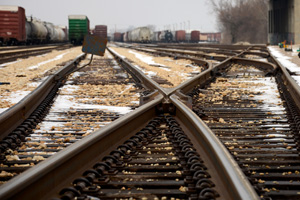As Freight Railroads Cut Spending, Manufacturers Take Hit

For more than a year now, prolonged downturns in the coal, oil and steel industries have meant much less traffic on freight railroads. The largest rail carriers in Pennsylvania have seen coal revenues cut by more than a third.
What’s become apparent this spring is that with less traffic comes less spending at firms that provide products and services to support infrastructure along the rail lines.
To see the pullback in spending, look no further than Wilmerding-based Wabtec Corp., a company that serves the freight and passenger rail industries, and Green Tree-based L.B. Foster, a provider of materials and accessories to build track and railcars.
In 2015, Wabtec’s freight rail business segment — which accounts for about 60% of revenues and includes products such as locomotive engines, freight cars and signaling systems — grew sales by 19% from 2014. That growth pushed up annual profits 13%, despite a 5% decline in sales in its passenger rail segment.
But in the first quarter of this year, the results were flipped. Last month, Wabtec reported its freight rail sales fell nearly 14% from the year-ago quarter, which dragged down earnings by 2% even though sales to passenger rail companies increased.
In an earnings call with investors, Wabtec Chairman Al Neupaver blamed the decline mostly on the largest freight rail carriers cutting capital expenditures.
“They basically have pulled back significantly,” Neupaver lamented. “That’s why they’ve performed so well, by the way. Kudos to them.”
L.B. Foster reported a similar situation in the first quarter. Its rail products and services segment declined 17%, which contributed to a quarterly loss of $2.8 million compared with a profit of $4.3 million in the year-ago quarter. Reduced sales to Union Pacific Railroad, a Nebraska-based carrier, accounted for more than half of the rail products decline, the company said.
“While the first quarter is traditionally our seasonally weakest quarter, the year got off to a particularly slow start, driven by reduced spending in the North American freight rail market,” company CEO said in a May 3 earnings call.
A decline in the coal markets has stung the railroad companies, which historically relied on coal country to deliver a steady chunk of revenue. Electric power plants largely have switched to burn cheaper natural gas, leaving coal in the stockpiles and shut down mines.
In April, U.S. coal carloads were down 40% compared with one year before, according to the Association of American Railroads, a Washington, D.C.-based industry group.
CSX Corp. and Norfolk Southern Corp., the two main line carriers that operate in Pennsylvania, have responded by decreasing their reliance on coal. For one, Jacksonville, Florida-based CSX has reduced coal’s share of revenues from 31% in 2011 to 19% in 2015.
But railroads also have cut expenses as a way to keep earnings on track.
In January, Norfolk Southern announced a four-year plan to cut $650 million through reduced overtime, facility closures, downsizing its car fleet and selling off rail lines. The company hopes to save $80 million on materials by 2020.
Expenses at CSX dipped 12% in the first quarter, in part because the company has been lengthening individual trains so there are fewer trips on the rails.
Capital projects have been curtailed as well. Nationally, railroads are planning to spend $26 billion on capital projects and maintenance in 2016, AAR spokesman Ed Greenberg said. That’s down from $30 billion in 2015 and from $28 billion in 2014.
CSX plans to spend $2.4 billion on capital improvements this year, down from $2.5 billion in 2015, company spokeswoman Melanie Cost said. Norfolk Southern is planning to spend $2.1 billion, down from $2.4 billion in 2015, according to regulatory filings.
Wabtec President, Raymond Betler said in an interview that the company was not surprised by the reversal of freight sales, given the drop in coal use. As one of the heaviest commodities hauled by railroads, coal “puts a lot of wear and tear on the equipment, and that’s obviously good for us,” Betler said.
Wabtec expects its new railcar build, along with its railcar loading equipment, to be down 20 to 25% this year due mostly to coal declines. “We don’t anticipate that’s going to change in the near term,” Betler said.
Still, Wabtec expects to grow through acquisitions, expanding into global markets, and developing communications and monitoring equipment. Wabtec hopes to acquire French company Faiveley Transport, a deal that would create one of the world’s largest public rail products companies with revenues of about $4.5 billion. European antitrust regulators currently are scrutinizing the deal.
Congress has mandated the installation by the end of 2018 of positive train control, a communications system that can take control of locomotives and prevent accidents, on the entire passenger rail network and freight railroads that carry hazardous substances.
Even after that deadline, Betler said, there are opportunities for upgrades of those systems. Wabtec would build off its acquisition last fall of Australian firm Track IQ, which produces sensors along the tracks to monitor the condition of bearings and wheels on railcars, he said.

